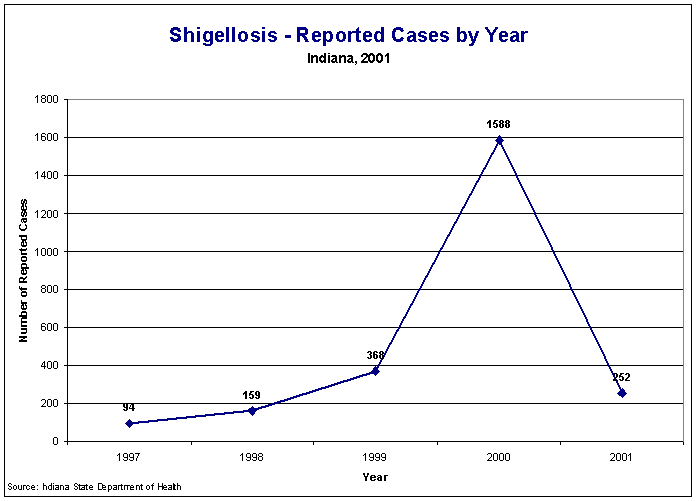Figure Shg1: Shigellosis - Reported Cases by Year, Indiana, 1997-2001

2001 Indiana Report of Infectious Diseases |
View ISDH's Quick Facts on Shigellosis
View CDC's Shigellosis page
Rates presented are per 100,000 population and are based on the 2000 U.S. Census.
| Cases | Incidence Rate |
|
| Total | 252 | 4.1 |
| Race-specific cases and rates1 | ||
| White | 110 | 2.1 |
| Black | 72 | 14.1 |
| Other2 | 6 | 2.4* |
| Sex-specific cases and rates3 | ||
| Female | 145 | 4.7 |
| Male | 106 | 3.6 |
Shigellosis is a bacterial disease transmitted by the fecal-oral route, usually through hands contaminated with feces. It can also be transmitted through contaminated food and water or through oral-anal sex practices. Shigellosis is highly communicable, as only 10-100 organisms must be ingested to establish infection. Shigella bacteria only infect humans.
In 2001, 252 cases of shigellosis were reported in Indiana, for a case rate of 4.1 per 100,000. This is consistent with the number of cases reported from 1997-1999 (Figure Shig1). Several large outbreaks occurred in 2000, greatly increasing the number of cases for that year. Since 1997, 2001 was the first year that the incidence of shigellosis infection has decreased. Shigellosis incidence generally varies within a five- to six-year cycle. Except for a high number of cases in January, the monthly incidence of shigellosis shows little discernible trend. (Figure Shig2)
Age-specific rates were highest among children ages 1-4 (24.5), followed by children ages 5-9 (12.6) (Figure Shig3). These high age-specific rates of shigellosis among preschool-aged and elementary school-aged children represent the increasing problem of shigellosis outbreaks in day-care centers and among younger elementary school-age children. The sex-specific incidence rate for females (4.7) was higher than that for males (3.6). The race-specific incidence rate for blacks (14.1) was over six times higher than that for whites (2.1).
Of those counties that reported 5 or more cases, Boone County had the highest incidence rate (47.7), followed by LaPorte (30.0), Dearborn (17.4), and Johnson (13.0). The number of reported cases for Indiana counties can be found in Table Shig1.
There are four species of Shigella bacteria. The serotype was determined for 222 (88%) of the 252 reported shigellosis cases (Figure 5). Shigella sonnei is the most common serotype isolated in the United States, and accounted for 207 (93%) of serotyped cases. Shigella flexneri is isolated less frequently and is usually related to exposures outside of the U.S. This serotype was isolated from 14 cases. Shigella boydii is rarely found in the U.S. and accounted for one case. Shigella dysenteriae, a serotype that can cause severe infection, is extremely uncommon in the U.S. and is almost always associated with exposures outside of the U.S. No Shigella dysenteriae cases were identified.
One outbreak of shigellosis occurred in Boone County. Throughout November and December, 24 cases were confirmed positive for Shigella sonnei: 16 of the cases attended the same day-care, 8 attended a local elementary school, 3 attended a preschool, 1 attended a local high school, and 2 cases were at-home contacts. Transmission occurred person-to-person. Infection may have been introduced through an ill child who attended the daycare. Several day-care children were ill with diarrhea weeks before the outbreak but were not diagnosed or treated. Once introduced into a vulnerable population, shigellosis can be difficult to control even with the most stringent measures due to its highly infectious nature.
Back to Top of Article
Back to Table of Contents
|
Figure Shg1: Shigellosis - Reported Cases by Year, Indiana, 1997-2001 |
|
|
Back to Reference in Text
Back to Top of Article
|
Figure Shg2: Shigellosis - Reported Cases by Month, Indiana, 2001 |
|
|
Back to Reference in Text
Back to Top of Article
|
Figure Shg3: Shigellosis - Incidence Rates by Age Group, Indiana, 2001 |
|
|
Back to Reference in Text
Back to Top of Article
|
Table Shig1: Shigellosis - Reported Cases by County, Indiana, 2001 |
|||||||||||||||||||||||||||||||||||||||||||||
|
|||||||||||||||||||||||||||||||||||||||||||||
Back to Reference in Text
Back to Top of Article
1 - Race was unknown for 64 of the reported cases.
2 - "Other" includes American Indian/Alaska Native, Asian, Native Hawaiian/Pacific Islander, and multiracial.
3 - Sex was unknown for 1 of the reported cases.
* - Rate based on less than 20 cases and should be considered unstable.
Back to Table of Contents
[an error occurred while processing this directive]